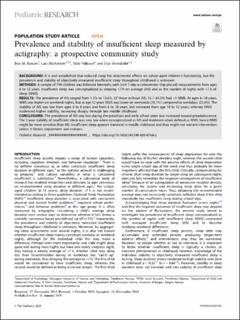| dc.contributor.author | Ranum, Bror | |
| dc.contributor.author | Wichstrøm, Lars | |
| dc.contributor.author | Pallesen, Ståle | |
| dc.contributor.author | Steinsbekk, Silje | |
| dc.date.accessioned | 2021-04-23T09:25:08Z | |
| dc.date.available | 2021-04-23T09:25:08Z | |
| dc.date.created | 2020-02-04T13:34:12Z | |
| dc.date.issued | 2020 | |
| dc.Published | Pediatric Research. 2020, 88 110-116. | |
| dc.identifier.issn | 0031-3998 | |
| dc.identifier.uri | https://hdl.handle.net/11250/2739300 | |
| dc.description.abstract | Background
It is well established that reduced sleep has detrimental effects on school-aged children’s functioning, but the prevalence and stability of objectively measured insufficient sleep throughout childhood is unknown.
Methods
A sample of 799 children was followed biennially with 24-h 7-day accelerometer (hip-placed) measurements from ages 6 to 12 years. Insufficient sleep was conceptualized as sleeping <7 h on average (AIS) and as the number of nights with <7 h of sleep (NNIS).
Results
The prevalence of AIS ranged from 1.1% to 13.6%. Of those without AIS, 15.1–64.5% had >1 NNIS. At ages 6–10 years, NNIS was higher on weekend nights, but at age 12 years NNIS was lower on weekends (18.1%) compared to weekdays (23.4%). The stability of AIS was low from ages 6 to 8 years and from 8 to 10 years, but increased from age 10 to 12 years, whereas NNIS evidenced higher stability, increasing sharply through late middle childhood.
Conclusions
The prevalence of AIS was low during the preschool and early school years but increased toward preadolescence. The 2-year stability of insufficient sleep was very low when conceptualized as AIS and moderate when defined as NNIS, hence NNIS might be more sensitive than AIS. Insufficient sleep appears transient in middle childhood and thus might not warrant intervention unless it fosters impairment and endures. | en_US |
| dc.language.iso | eng | en_US |
| dc.publisher | Nature | en_US |
| dc.rights | Navngivelse 4.0 Internasjonal | * |
| dc.rights.uri | http://creativecommons.org/licenses/by/4.0/deed.no | * |
| dc.title | Prevalence and stability of insufficient sleep measured by actigraphy: a prospective community study | en_US |
| dc.type | Journal article | en_US |
| dc.type | Peer reviewed | en_US |
| dc.description.version | publishedVersion | en_US |
| dc.rights.holder | Copyright 2020 The Authors | en_US |
| cristin.ispublished | true | |
| cristin.fulltext | postprint | |
| cristin.qualitycode | 1 | |
| dc.identifier.doi | 10.1038/s41390-020-0768-y | |
| dc.identifier.cristin | 1790740 | |
| dc.source.journal | Pediatric Research | en_US |
| dc.source.40 | 88 | |
| dc.source.pagenumber | 110-116 | en_US |
| dc.relation.project | Samarbeidsorganet mellom Helse Midt-Norge og NTNU: 000000 | en_US |
| dc.relation.project | Norges forskningsråd: ES611813 | en_US |
| dc.relation.project | Norges forskningsråd: 228685 | en_US |
| dc.identifier.citation | Pediatric Research. 2020, 88, 110–116 | en_US |
| dc.source.volume | 88 | en_US |

